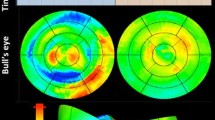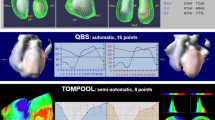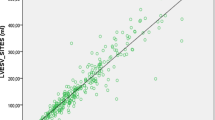Abstract
Introduction
Left (LVEF) and right ventricular ejection fraction (RVEF) as well as LV regional wall motion at rest are valuable tools to monitor and tailor treatment of congestive heart failure (CHF) patients. Gated blood pool SPECT (GBPS) is under evaluation as an “all-in-one” technique, providing information on LVEF, RVEF, and wall motion derived from a single examination. Aim of the study was to evaluate a commercially available automated GBPS processing software for EF measurements and wall motion analysis in heart failure patients.
Methods
Thirty-two patients (12 female; mean age±SD: 53±13 years), suffering from dilated (63%), ischemic (25%) or hypertrophic (13%) cardiomyopathy, were studied. First-pass radionuclide ventriculography (FP-RNV), planar multigated radionuclide angiography (MUGA), and GBPS were performed at rest after in vivo labeling of red blood cells, and LVEF and RVEF was calculated with each method. Later on the same day LVEF was calculated by echocardiography. LV wall motion (summed motion score and wall motion index) was derived from GBPS and echocardiography using the standard 16-segment model.
Results
Mean LVEF measured by GBPS, echocardiography, MUGA and FP-RNV was 33±13%, 37±15%, 41±14% and 45±13%, respectively. LVEF values calculated from GBPS showed moderate to good correlation with FP-RNV (r=0.61), MUGA (r=0.65) and ECHO (r=0.74; all p<0.01). Mean RVEF calculated by GBPS, FP-RNV and MUGA was 45±14%, 46±9% and 38±9%, respectively. RVEF values calculated from GBPS showed weak correlation with FP-RNV (r=0.33) and MUGA (r=0.26; all p=n.s.). Assessment of GBPS wall motion was qualitatively possible in all patients. The agreement between GBPS and ECHO was 82% (κ=0.73). The wall motion index showed good correlation between both methods (r=0.88; p<0.001).
Conclusion
An automated algorithm for LVEF calculation and wall motion analysis using GBPS is feasible for clinical routine diagnostic in CHF patients. The RVEF calculation method needs to be improved before routine clinical application can be recommended.
Similar content being viewed by others
Abbreviations
- CHF:
-
congestive heart failure
- FP-RNV:
-
first-pass radionuclide ventriculography
- GBPS:
-
gated blood pool SPECT
- LVEF:
-
left ventricular ejection fraction
- MRI:
-
magnetic resonance imaging
- MUGA:
-
multigated radionuclide angiography
- ROI:
-
region of interest
- RVEF:
-
right ventricular ejection fraction
References
de Groote P, Millaire A, Foucher-Hossein C, et al. (1998). Right ventricular ejection fraction is an independent predictor of survival in patients with moderate heart failure. J Am Coll Cardiol. 32: 948–954
Effect of enalapril on survival in patients with reduced left ventricular ejection fractionsand congestive heart failure. The SOLVD Investigators. N Engl J Med 1991; 325: 293–302.
3. Hughes CV, Wong M, Johnson G, Cohn JN (1993). Influence of age on mechanisms and prognosis of heart failure. The V-HeFT VA Cooperative Studies Group. Circulation. 87:VI111–117
Cohn JN, Johnson GR, Shabetai R, et al. (1993). Ejection fraction, peak exercise oxygen consumption, cardiothoracic ratio, ventricular arrhythmias, and plasma norepinephrine as determinants of prognosis in heart failure. The V-HeFT VA Cooperative Studies Group. Circulation. 87:VI5–16
Gradman A, Deedwania P, Cody R, et al. (1989). Predictors of total mortality and sudden death in mild to moderate heart failure. Captopril-Digoxin Study Group. J Am Coll Cardiol. 14:564–570
Di Salvo TG, Mathier M, Semigran MJ, Dec GW. (1995). Preserved right ventricular ejection fraction predicts exercise capacity and survival in advanced heart failure. J Am Coll Cardiol. 25:1143–1153
Parameshwar J, Keegan J, Sparrow J, Sutton GC, Poole-Wilson PA. (1992) Predictors of prognosis in severe chronic heart failure. Am Heart J. 123:421–426
Fauchier L, Eder V, Casset-Senon D, et al. (2004). Segmental wall motion abnormalities in idiopathic dilated cardiomyopathy and their effect on prognosis. Am J Cardiol. 93:1504–1509
Vanhove C, Franken PR. (2001). Left ventricular ejection fraction and volumes from gated blood pool tomography: comparison between two automatic algorithms that work in three-dimensional space. J Nucl Cardiol. 8:466–471
Vanhove C, Franken PR, Defrise M, Momen A, Everaert H, Bossuyt A. (2001). Automatic determination of left ventricular ejection fraction from gated blood-pool tomography. J Nucl Med. 42:401–407
Chin BB, Bloomgarden DC, Xia W, et al. (1997). Right and left ventricular volume and ejection fraction by tomographic gated blood-pool scintigraphy. J Nucl Med. 38:942–948
Bartlett ML, Srinivasan G, Barker WC, Kitsiou AN, Dilsizian V, Bacharach SL. (1996). Left ventricular ejection fraction: comparison of results from planar and SPECT gated blood-pool studies. J Nucl Med. 37:1795–1799
Faber TL, Stokely EM, Templeton GH, Akers MS, Parkey RW, Corbett JR. (1989). Quantification of three-dimensional left ventricular segmental wall motion and volumes from gated tomographic radionuclide ventriculograms. J Nucl Med. 30:638–649
Links JM, Becker LC, Shindledecker JG, et al. (1982). Measurement of absolute left ventricular volume from gated blood pool studies. Circulation. 65:82–91
Nichols K, Saouaf R, Ababneh AA, et al. (2002). Validation of SPECT equilibrium radionuclide angiographic right ventricular parameters by cardiac magnetic resonance imaging. J Nucl Cardiol. 9:153–160
Eder V, Bernis F, Drumm M, Diarra MI, Baulieu F, Leger C. (2004). Three-dimensional analysis of left ventricle regional wall motion by using gated blood pool tomography. Nucl Med Commun. 25:971–978
Calnon DA, Kastner RJ, Smith WH, Segalla D, Beller GA, Watson DD. (1997). Validation of a new counts-based gated single photon emission computed tomography method for quantifying left ventricular systolic function: comparison with equilibrium radionuclide angiography. J Nucl Cardiol. 4:464–471
Groch MW, DePuey EG, Belzberg AC, et al. (2001). Planar imaging versus gated blood-pool SPECT for the assessment of ventricular performance: a multicenter study. J Nucl Med. 42:1773–1779
Groch MW, Marshall RC, Erwin WD, Schippers DJ, Barnett CA, Leidholdt EM, Jr. (1998). Quantitative gated blood pool SPECT for the assessment of coronary artery disease at rest. J Nucl Cardiol. 5:567–573
Fischman AJ, Moore RH, Gill JB, Strauss HW. (1989). Gated blood pool tomography: a technology whose time has come. Semin Nucl Med. 19:13–21
Corbett JR, Jansen DE, Lewis SE, et al. (1985). Tomographic gated blood pool radionuclide ventriculography: analysis of wall motion and left ventricular volumes in patients with coronary artery disease. J Am Coll Cardiol. 6:349–358
Moore ML, Murphy PH, Burdine JA (1980). ECG-gated emission computed tomography of the cardiac blood pool. Radiology. 134:233–235
Daou D, Harel F, Helal BO, et al. (2001). Electrocardiographically gated blood-pool SPECT and left ventricular function: comparative value of 3 methods for ejection fraction and volume estimation. J Nucl Med. 42:1043–1049
Daou D, Coaguila C, Benada A, et al. (2004). The value of a completely automatic ECG gated blood pool SPECT processing method for the estimation of global systolic left ventricular function. Nucl Med Commun. 25:271–276
Van Kriekinge SD, Berman DS, Germano G (1999). Automatic quantification of left ventricular ejection fraction from gated blood pool SPECT. J Nucl Cardiol. 6:498–506
Nichols K, Humayun N, De Bondt P, Vandenberghe S, Akinboboye OO, Bergmann SR (2004). Model dependence of gated blood pool SPECT ventricular function measurements. J Nucl Cardiol. 11:282–292
De Bondt P, Nichols K, Vandenberghe S, et al. (2003). Validation of gated blood-pool SPECT cardiac measurements tested using a biventricular dynamic physical phantom. J Nucl Med. 44:967–972
Daou D, Van Kriekinge SD, Coaguila C, et al. (2004). Automatic quantification of right ventricular function with gated blood pool SPECT. J Nucl Cardiol. 11:293–304
Vourvouri EC, Poldermans D, Bax JJ, et al. (2001). Evaluation of left ventricular function and volumes in patients with ischaemic cardiomyopathy: gated single-photon emission computed tomography versus two-dimensional echocardiography. Eur J Nucl Med. 28:1610–1615
Schiller NB, Acquatella H, Ports TA, et al. (1979). Left ventricular volume from paired biplane two-dimensional echocardiography. Circulation. 60:547–555
Schiller NB, Shah PM, Crawford M, et al. (1989). Recommendations for quantitation of the left ventricle by two-dimensional echocardiography. American Society of Echocardiography Committee on Standards, Subcommittee on Quantitation of Two-Dimensional Echocardiograms. J Am Soc Echocardiogr. 2:358–367
Weiss JL, Eaton LW, Kallman CH, Maughan WL (1983). Accuracy of volume determination by two-dimensional echocardiography: defining requirements under controlled conditions in the ejecting canine left ventricle. Circulation. 67:889–895
Gordon EP, Schnittger I, Fitzgerald PJ, Williams P, Popp RL (1983). Reproducibility of left ventricular volumes by two-dimensional echocardiography. J Am Coll Cardiol. 2:506–513
Otterstad JE, Froeland G, St John Sutton M, Holme I (1997). Accuracy and reproducibility of biplane two-dimensional echocardiographic measurements of left ventricular dimensions and function. Eur Heart J. 18:507–513
Popp RL (1980). ASE recommendations. Circulation. 62:1142–1143
Wright GA, Thackray S, Howey S, Cleland JG (2003). Left Ventricular Ejection Fraction and Volumes from Gated Blood-Pool SPECT: Comparison with Planar Gated Blood-Pool Imaging and Assessment of Repeatability in Patients with Heart Failure. J Nucl Med. 44:494–498
Germano G, Kiat H, Kavanagh PB, et al. (1995). Automatic quantification of ejection fraction from gated myocardial perfusion SPECT. J Nucl Med. 36:2138–2147
Kim SJ, Kim IJ, Kim YS, Kim YK (2005). Gated blood pool SPECT for measurement of left ventricular volumes and left ventricular ejection fraction: comparison of 8 and 16 frame gated blood pool SPECT. Int J Cardiovasc Imaging. 21:261–266
Adachi I, Umeda T, Shimomura H, et al. (2005). Comparative study of quantitative blood pool SPECT imaging with 180 degrees and 360 degrees acquisition orbits on accuracy of cardiac function. J Nucl Cardiol. 12:186–194
Hacker M, Stork S, Stratakis D, et al. (2003). Relationship between right ventricular ejection fraction and maximum exercise oxygen consumption: a methodological study in chronic heart failure patients. J Nucl Cardiol. 10:644–649
Slart RH, Poot L, Piers DA, et al. (2003). Evaluation of right ventricular function by NuSMUGA software: gated blood-pool SPECT vs. first-pass radionuclide angiography. Int J Cardiovasc Imaging. 19:401–407
Bacher-Stier C, Muller S, Pachinger O, et al. (1999). Thallium-201 gated single-photon emission tomography for the assessment of left ventricular ejection fraction and regional wall motion abnormalities in comparison with two-dimensional echocardiography. Eur J Nucl Med. 26:1533–1540
Dec GW, Fuster V (1994). Idiopathic dilated cardiomyopathy. N Engl J Med. 331:1564–1575
Author information
Authors and Affiliations
Corresponding author
Rights and permissions
About this article
Cite this article
Hacker, M., Hoyer, X., Kupzyk, S. et al. Clinical validation of the gated blood pool SPECT QBS® processing software in congestive heart failure patients: correlation with MUGA, first-pass RNV and 2D-echocardiography. Int J Cardiovasc Imaging 22, 407–416 (2006). https://doi.org/10.1007/s10554-005-9031-1
Received:
Accepted:
Published:
Issue Date:
DOI: https://doi.org/10.1007/s10554-005-9031-1




